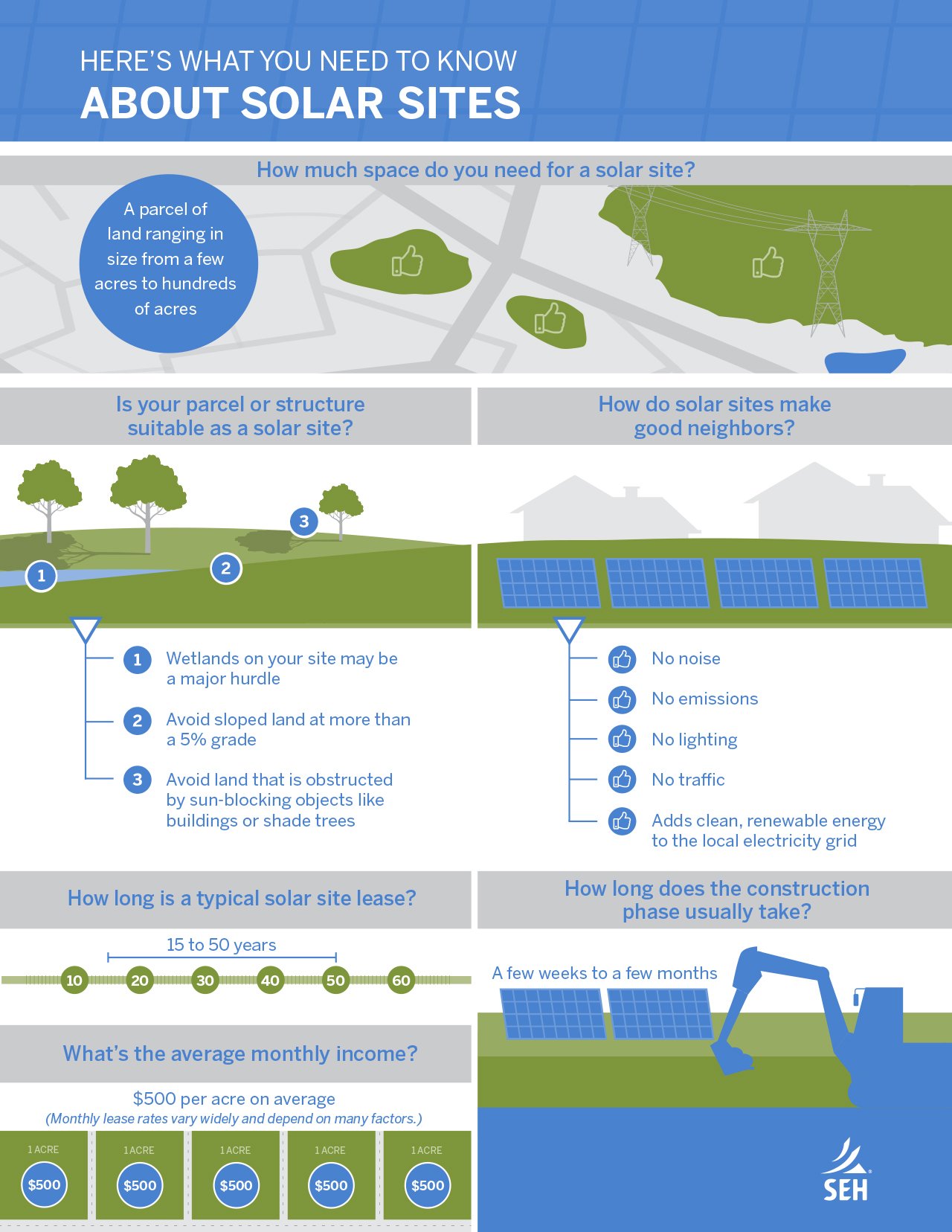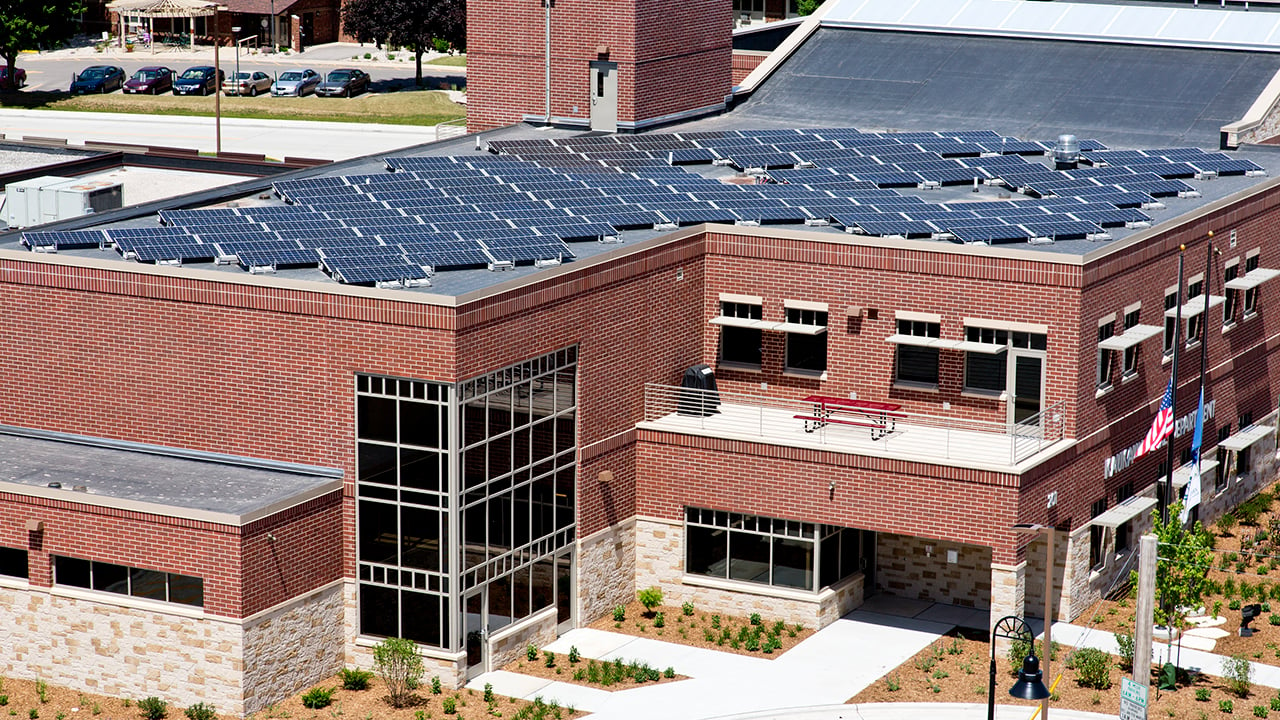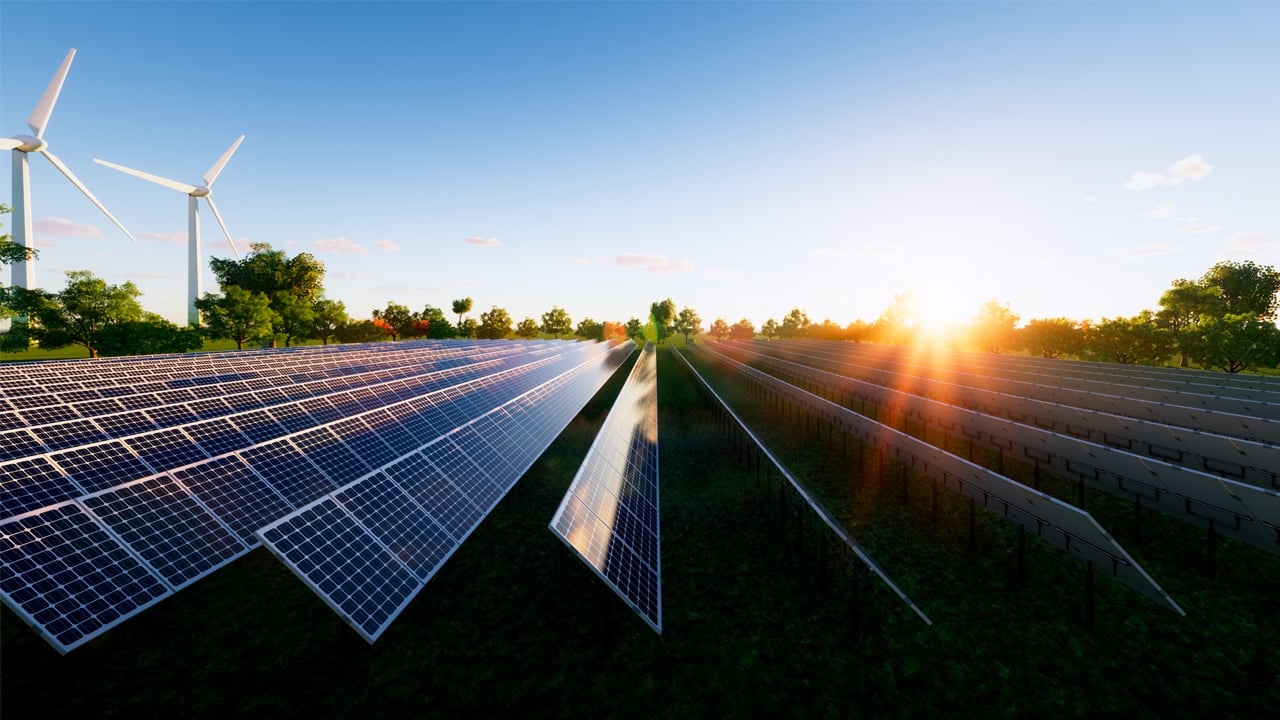Do you own an empty parcel of land or a large rooftop that sits open to the sky? If the sun shines mostly unimpeded on it, you may be able to lease the space to a utility company or solar developer to generate renewable energy and compensate you for using the land or rooftop.
Solar sites can generate revenue and clean energy for communities and landowners. Many types of landowners – municipalities, school districts, universities, individuals and businesses – can turn this idea into reality.
Let’s explore what solar sites are. We’ll also discuss three things that need to be evaluated to determine if your land or structures are the right fit. Keep in mind that state and local laws must be considered. But with this information in hand, you can get started down the path to put your property to work providing renewable energy from a sustainable source – and perhaps generate new income.
Where should you begin?

What exactly are solar sites?
Unused land or structures can become solar sites specifically when paired with the sun as a powerful energy source. The land or roof is put to work by providing space and support for ground-mounted or rooftop solar panels. Other terms used to describe solar sites include solar farms, solar gardens and solar parks.
As energy companies look for more ways to generate renewable energy, they are investing in community solar sites that generate electricity and send it to the local electrical grid. Once a site is determined to be a fit, an energy company will work with a solar developer to install the system and pay the landowner to use the space.
This agreement can result in the landowner generating extra revenue – all from a previously unused piece of land or rooftop. And the solar energy produced is then available to nearby entities (governmental, commercial and residential) as well as your property.

How does a leasing program work?
In some cases, an energy company leases the land from the property owner and pays for the design and installation of the solar equipment at little cost or risk for you.
Leases are known to span from 15 to 50 years. Solar rent is usually higher for small-scale, community-based sites of only a few acres than large rural solar projects spanning hundreds of acres due to better access to existing electrical infrastructure. Lease rates vary but it's our opinion that based on our experience, the average monthly lease rate in the U.S. is $500 per acre.
Another option is for the landowner to work directly with a solar developer to build a solar site and sell the energy to a utility company. These projects are highly dependent on state solar incentives and specific utility companies.
Is your parcel or structure suitable as a solar site?
The idea of generating revenue by leasing your space is enticing. But first, it’s important to uncover whether a solar site would fit and operate properly on your property. Not everyone is eligible to have a solar site on their land, but it’s more than you might think. Solar sites can vary in size or shape, but many factors go into determining if your empty field or structure is feasible.
A rooftop needs to be structurally sound and have enough unimpeded space to house an appropriate amount of solar panels. A parcel of land ranging in size from only a few acres to hundreds of acres may become a solar site. The topography may play a role in the land's suitability to serve as a solar site. Below, we explain further how to know if your land fits the criteria required.
Not everyone is eligible to have a solar site on their land, but it’s more than you might think. Many factors go into determining if your empty field or structure is feasible.
– Keith Kindred, SEH Regional Survey Leader
3 important factors to consider
Deciding to lease a parcel of land or an empty rooftop to an energy company as a solar site is just the beginning of a complex process. A professional consultant partner can help raise crucial questions, provide answers and chart the best way forward. These three factors can help you determine if your land is a fit:
1. Site evaluation, including environmental review
Early in the project planning process, determine the level of environmental review needed for potential environmental impacts. The existence and location of wetlands are among the most significant factors for locating solar site projects. Your state wetland protection laws will play a large role in determining if and where a solar site is feasible.
Different states have different stipulations on the distance a structure needs to be from a wetland and classifications for what is considered a wetland. Keep in mind that wetlands are not always wet. Some wetlands are farmed, mowed for hay or managed as a lawn.
The best way to determine if your land qualifies is through a proper environmental delineation. Wetland delineators are versed in each state’s wetland regulations and can determine the exact borders in question.
2. Topographic and legal survey
Each parcel of land is unique. Two factors to consider are its physical properties that determine how much sunlight would reach solar panels and who has legal interests in the land.
Let’s start with the topographical survey – the shape and placement of the land. Parcels of flat land that aren’t obstructed by sun-blocking objects like buildings or shade trees may be ideal for a solar site. It's another story if there is a slope, however. Solar companies typically avoid hilly land that slopes at more than a 5% grade.

A topographic survey can usually indicate if your land qualifies. A typical survey takes place on the ground, but more sophisticated survey techniques can take place in the air and involve drones.
Legal ownership of the land also needs to be considered early on to avoid major project delays. It may seem apparent that the landowner can legally lease the land for a solar site, but legal rights held by others could delay or halt a project. Research and fieldwork should be performed regarding easements, right-of-way, legal title, mortgage restrictions and more.
3. Be a good neighbor
Neighbors tend to take interest when the use of a land parcel changes. If you’re looking into leasing your land to an energy company to build a solar site, be ready to share the reasons why solar sites make good neighbors. A solar site contains neat rows of silent equipment that adds clean, renewable energy to the local electricity grid. Creating visualizations can go a long way to help neighbors get comfortable with an upcoming solar project.

The construction time frame is relatively brief, ranging from a few weeks to a few months. After construction, a solar site runs itself and requires only periodic maintenance (which oftentimes isn’t your responsibility). Solar projects create no noise, no emissions, no lighting and no traffic. The benefits to the environment cannot be overstated, either. By providing the space to produce energy from the sun, a renewable resource, landowners can play a role in protecting the environment for future generations.
Win-win-win for landowners, solar developers and the environment
Leasing your land as a solar site can provide a consistent source of revenue while boosting sustainability in your community. This is a winning situation for any municipality, school district, organization, business or individual with unused land or a building rooftop that the sun can reach most of the day.
These open community spaces are increasingly in demand, as energy companies and solar developers seek alternative and sustainable ways to generate electricity.
Getting started
Need help getting started to see if your property is suitable as a solar site? Connect with our solar site experts by filling out the form below.
About the Author

Keith Kindred, PE* is a senior associate who leads the SEH survey practice in Wisconsin, Michigan and Indiana. He has been an instrumental leader of SEH solar projects from early site selection through construction. Keith’s portfolio of public and private solar site work highlights his dedication to helping communities, developers and industries discover responsible new ways to generate revenue.
*Registered Professional Engineer in IL, WI


